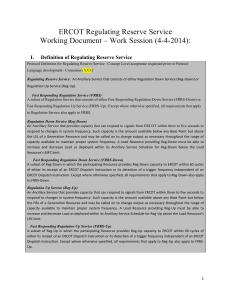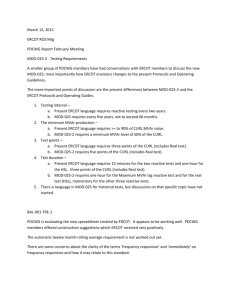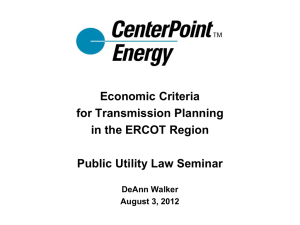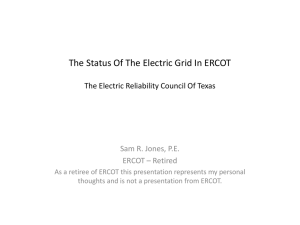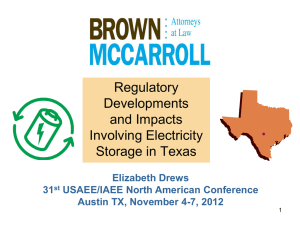Regulation Discussion Paper as of 04082014_1140
advertisement
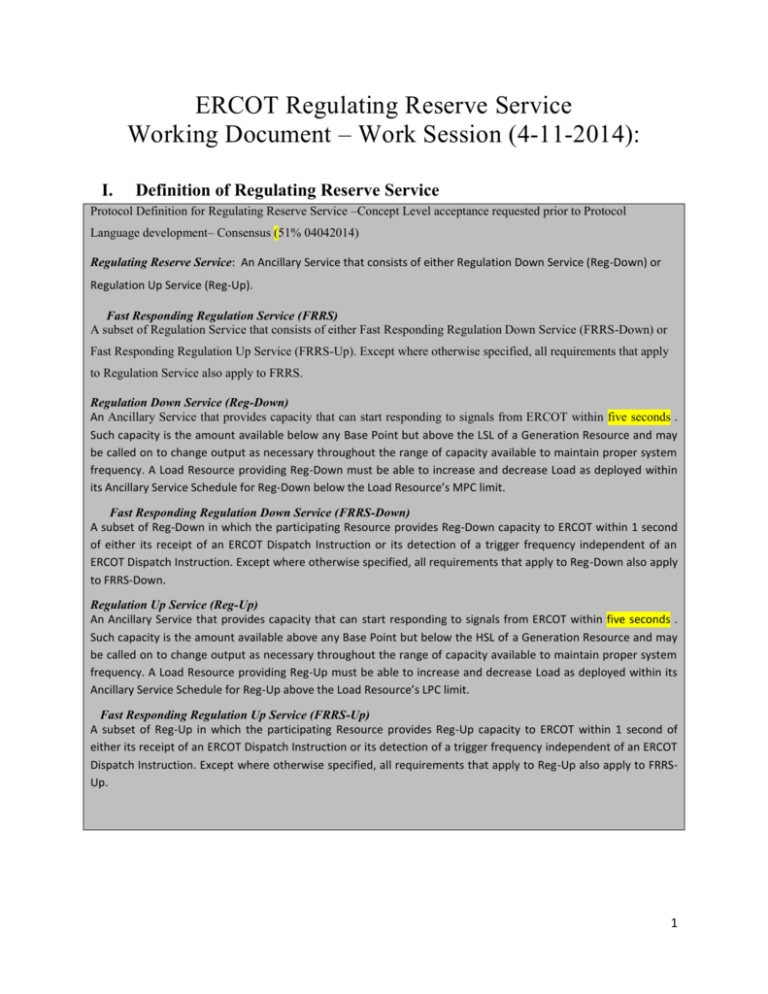
ERCOT Regulating Reserve Service Working Document – Work Session (4-11-2014): I. Definition of Regulating Reserve Service Protocol Definition for Regulating Reserve Service –Concept Level acceptance requested prior to Protocol Language development– Consensus (51% 04042014) Regulating Reserve Service: An Ancillary Service that consists of either Regulation Down Service (Reg-Down) or Regulation Up Service (Reg-Up). Fast Responding Regulation Service (FRRS) A subset of Regulation Service that consists of either Fast Responding Regulation Down Service (FRRS-Down) or Fast Responding Regulation Up Service (FRRS-Up). Except where otherwise specified, all requirements that apply to Regulation Service also apply to FRRS. Regulation Down Service (Reg-Down) An Ancillary Service that provides capacity that can start responding to signals from ERCOT within five seconds . Such capacity is the amount available below any Base Point but above the LSL of a Generation Resource and may be called on to change output as necessary throughout the range of capacity available to maintain proper system frequency. A Load Resource providing Reg-Down must be able to increase and decrease Load as deployed within its Ancillary Service Schedule for Reg-Down below the Load Resource’s MPC limit. Fast Responding Regulation Down Service (FRRS-Down) A subset of Reg-Down in which the participating Resource provides Reg-Down capacity to ERCOT within 1 second of either its receipt of an ERCOT Dispatch Instruction or its detection of a trigger frequency independent of an ERCOT Dispatch Instruction. Except where otherwise specified, all requirements that apply to Reg-Down also apply to FRRS-Down. Regulation Up Service (Reg-Up) An Ancillary Service that provides capacity that can start responding to signals from ERCOT within five seconds . Such capacity is the amount available above any Base Point but below the HSL of a Generation Resource and may be called on to change output as necessary throughout the range of capacity available to maintain proper system frequency. A Load Resource providing Reg-Up must be able to increase and decrease Load as deployed within its Ancillary Service Schedule for Reg-Up above the Load Resource’s LPC limit. Fast Responding Regulation Up Service (FRRS-Up) A subset of Reg-Up in which the participating Resource provides Reg-Up capacity to ERCOT within 1 second of either its receipt of an ERCOT Dispatch Instruction or its detection of a trigger frequency independent of an ERCOT Dispatch Instruction. Except where otherwise specified, all requirements that apply to Reg-Up also apply to FRRSUp. 1 II. Need for Regulating Reserve Service Protocol Definition for Regulating Reserve Service –Concept Level acceptance requested prior to Protocol Language development– Consensus (XXX) ERCOT generation is dispatched through Security Constrained Economic Dispatch (SCED) to balance the generation and demand. The power imbalance between each SCED interval will cause frequency deviation that requires regulating reserve to compensate. RR service will not substantially change from where it is today. The proposed changes are discussed in next section. Definition of NERC Regulating Reserve An amount of reserve responsive to Automatic Generation Control, which is sufficient to provide normal regulating margin. Per BAL-005-0.1b. R2. Each Balancing Authority shall maintain Regulating Reserve that can be controlled by AGC to meet the Control Performance Standard. (NERC BAL-001 Standard) Communication mechanism-keep same Pay for performance proposed by 0404 Work-session participants PUC rules requires resource obligated in day-ahead to provide AS in real-time (TF) - This statement needs further understanding. 2 Deployment, Sustain and Recall Requirements for Regulating Reserve III. Protocol Definition for Regulating Reserve Service –Concept Level acceptance requested prior to Protocol Language development– Consensus (XXX) Load Frequency Control (LFC) The deployment of those Resources that are providing Regulation Service to ensure that system frequency is maintained within predetermined limits and the deployment of those Resources providing CR1 when necessary to backup regulation. Resources must be able to fully sustain regulation deployments for the entire duration they have responsibility and are deployed by LFC. They should also be able to follow the recall instructions. Section 6.5.7.6.1 LFC Process Description of Nodal Protocol provides additional details on deployment of regulation service through LFC. Regulation Up (Reg-Up) Service is a service that provides capacity that can respond to signals from ERCOT within five seconds. . The amount of Reg-Up capacity is the amount of capacity available from a Resource that may be called on to change output as necessary to maintain proper system frequency. A Generation Resource providing Reg-Up must be able to increase energy output when deployed and decrease energy output when recalled. A Load Resource providing Reg-Up must be able to decrease Load when deployed and increase Load when recalled. Fast-Responding Regulation Service Up (FRRS-Up) is a subset of Reg-Up Service in which the participating Resource provides Reg-Up capacity to ERCOT within one second of either its receipt of an ERCOT Dispatch Instruction or the detection of a trigger frequency independent of an ERCOT Dispatch Instruction. ERCOT dispatches Reg-Up by a Load Frequency Control (LFC) signal. The LFC signal for FRRS-Up is separate from the LFC signal for other Reg-Up. Regulation Down (Reg-Down) Service is a service that provides capacity that can respond to signals from ERCOT within five seconds. The amount of Reg-Down capacity is the amount of capacity available from a Resource that may be called on to change output as necessary to maintain proper system frequency. A Generation Resource providing Reg-Down must be 3 able to decrease energy output when deployed and increase energy output when recalled. A Load Resource providing Reg-Down must be able to increase Load when deployed and decrease Load when recalled. Fast-Responding Regulation Service Down (FRRS-Down) is a subset of Reg-Down Service in which a participating Resource provides Reg-Down capacity to ERCOT within one second of either its receipt of an ERCOT Dispatch Instruction or the detection of a trigger frequency independent of an ERCOT Dispatch Instruction. ERCOT dispatches Reg-Down by an LFC signal. The LFC signal for FRRS-Down is separate from the LFC signal for other Reg-Down. IV. Performance Measurement Protocol Definition for Regulating Reserve Service –Concept Level acceptance requested prior to Protocol Language development– Consensus (XXX) 1. GREDP for Resources providing Regulation Reserve Service must be less than 2. 3. V. or equal to 5 %. (alternatively the FAST could explore Sydney’s CPS1 type metric for Resources providing Regulation Services) -put MW limit as tolerance FRRS Resources must demonstrate their full responsibility for sudden low frequency event. Failure to respond to more than 1 event each month will result in disqualification. Tighter performance metric Limits on Resources providing Regulation Service 4 Protocol Definition for Regulating Reserve Service –Concept Level acceptance requested prior to Protocol Language development– Consensus (XXX) Since Regulating Reserve is intended to balance the system between five-minute SCED intervals, their deployment and recall capability needs to be consistent. If same Resources are carrying both Regulation-up and Regulation-Down, then Regulation-up has to be fully recalled before Regulation down can be deployed. When Regulation-Up is being recalled, it does act like regulation down so the ramp rate has to be consistent. VI. Resources providing RR and participating in Energy Market (SCED) should be limited to min(NURR,NDRR)*5*0.70, where NURR and NDRR are Normal-Up Ramp Rate and Normal-Down Ramp Rate Resources providing RR and not participating in Energy Market (SCED) should be limited to min(NURR,NDRR)*5, where NURR and NDRR are Normal-Up Ramp Rate and Normal-Down Ramp RateERCOT will describe how the signal is calculated and deployed so as not to over respond and cause other issues The factor of 0.7 is included to prevent SCED from using up the entire ramping capability on units carrying RR, thus leaving 70% ramping capability to respond if Regulating Reserve deployment is needed. ERCOT proposes that a single Resource be not allowed to carry more than 25% of total regulation requirement for that particular hour. Resources providing regulating reserve should be able to closely follow ERCOT Load Frequency Control (LFC) signal for Regulation to be effective Qualification of Resources Providing Regulation Service 5 Protocol Concept – Consensus acceptance requested prior to Protocol Language development: (XXXX) Regulation Service Qualification (1) A QSE control system must be capable of receiving Regulation Up Service (Reg-Up) and Regulation Down Service (Reg-Down) control signals from ERCOT’s Load Frequency Control (LFC) system, and of directing its Resources to respond to the control signals, in an upward and downward direction to balance Real-Time Demand and Resources. A QSE providing Reg-Up or Reg-Down shall provide communications equipment to receive telemetered control deployments of power from ERCOT. (2) A QSE shall demonstrate to ERCOT that they have the ability to switch control to constant frequency operation as specified in the Operating Guides. ERCOT’s direction to the QSE to operate on constant frequency will be considered a Dispatch Instruction. (3) Resources shall be qualified for the amount successfully tested during the qualification test. (4) A Resource providing Fast Responding Regulation Service (FRRS) shall be capable of independently detecting and recording system frequency with an accuracy of at least one mHz and a resolution of no less than 32 samples per second. The Resource shall also be capable of measuring and recording MW output with a resolution of no less than 32 samples per second. A Reg-Up and Reg-Down qualification test for each Resource is conducted during a continuous 60-minute period agreed on in advance by the QSE and ERCOT. QSEs may qualify a Resource to provide Reg-Up or Reg-Down, or both, in separate testing (additional details provided in 8.1.1.2.1.1 Regulation Service Qualification of nodal protocol). 6 VII. Methodology to Determine Requirement for Regulation service ERCOT as the system Reliability Coordinator will determine the minimum amount of Regulating Reserve that must be available in each hour of the Operating Day to meet the NERC Control Performance Standard (CPS1). ERCOT will use 5-minute net load variability and shortterm load forecast error for identifying amount of regulation needed for each hour. ERCOT will limit total Regulation Service that can come from Resources providing FRRS to X% of total system wide regulation requirement. 1. Criteria for CAP to be part of the AS Methodology document. . 7
